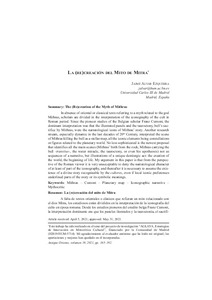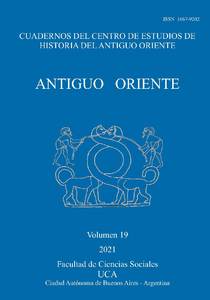Por favor, use este identificador para citar o enlazar este ítem:
https://repositorio.uca.edu.ar/handle/123456789/14535| Título: | La (re)creación del mito de Mitra The (re)creation of the myth of Mithras |
Autor: | Alvar Ezquerra, Jaime | Palabras clave: | HISTORIA ANTIGUA; HISTORIA DE ROMA; MITOS; RELIGIONES ANTIGUAS; ICONOGRAFIA; TORO; Cumont, Franz, 1868-1947 | Fecha de publicación: | 2021 | Editorial: | Pontificia Universidad Católica Argentina. Facultad de Ciencias Sociales. Departamento de Historia. Centro de Estudios de Historia del Antiguo Oriente | Cita: | Alvar Ezquerra, J. La (re)creación del mito de Mitra [en línea]. Antiguo Oriente. 2021, 19. Disponible en: https://repositorio.uca.edu.ar/handle/123456789/14535 | Resumen: | Summary: The (Re)creation of the Myth of Mithras
In absence of oriental or classical texts referring to a myth related to the god
Mithras, scholars are divided in the interpretation of the iconography of the cult in
Roman period. Since the pioneer studies of the Belgian scholar Franz Cumont, the
dominant interpretation was that the illustrated panels and the tauroctony, bull’s sacrifice by Mithras, were the narratological icons of Mithras’ story. Another research
stream, especially dynamic in the last decades of 20th Century, interpreted the scene
of Mithras killing the bull as a stellar map, all the iconic elements being constellations
or figures related to the planetary world. No less sophisticated is the newest proposal
that identifies all the main scenes (Mithras’ birth from the rock, Mithras carrying the
bull -transitus-, the water miracle, the tauroctony, or even his apotheosis) not as
sequences of a narrative, but illustrations of a unique demiurgic act: the creation of
the world, the beginning of life. My argument in this paper is that from the perspective of the Roman viewer it is very unacceptable to deny the narratological character
of at least of part of the iconography, and thereafter it is necessary to assume the existence of a divine story recognisable by the cultores, even if local iconic preferences
underlined parts of the story or its symbolic meanings. Resumen: La (re)creación del mito de Mitra A falta de textos orientales o clásicos que refieran un mito relacionado con el dios Mitra, los estudiosos están divididos en la interpretación de la iconografía del culto en época romana. Desde los estudios pioneros del erudito belga Franz Cumont, la interpretación dominante era que los paneles ilustrados y la tauroctonía, el sacrificio del toro por Mitra, eran los iconos narratológicos de la historia de Mitra. Otra corriente de investigación, especialmente dinámica en las últimas décadas del siglo XX, interpretó la escena de Mitra matando al toro como un mapa estelar, pues todos los elementos icónicos eran constelaciones o figuras relacionadas con el ámbito planetario. No menos sofisticada es la propuesta más reciente que identifica todas las escenas principales (el nacimiento de Mitra de la roca, Mitra cargando el toro -transitus-, el milagro del agua, la tauroctonía, o incluso su apoteosis) no como secuencias de una narración, sino ilustraciones de un acto demiúrgico único: la creación del mundo, el comienzo de la vida. Lo que se plantea en este trabajo es que, desde la perspectiva del espectador romano, es difícil negar el carácter narratológico al menos de una parte de la iconografía, por lo que es necesario asumir la existencia de una historia divina reconocible por los cultores, aunque las preferencias icónicas locales subrayaran partes de la historia o de sus significados simbólicos. |
URI: | https://repositorio.uca.edu.ar/handle/123456789/14535 | ISSN: | 1667-9202 | Disciplina: | HISTORIA | Derechos: | Acceso abierto | Fuente: | Antiguo Oriente. 2021, 19 |
| Aparece en las colecciones: | AO - 2021 vol. 19 AO - 2021 vol. 19 |
Ficheros en este ítem:
| Fichero | Descripción | Tamaño | Formato | |
|---|---|---|---|---|
| re-creacion-mito-mitra.pdf | 442,16 kB | Adobe PDF |  Visualizar/Abrir | |
| thumb.jpg | 124 kB | JPEG |  Visualizar/Abrir |
Visualizaciones de página(s)
332
comprobado en 27-abr-2024
Descarga(s)
576
comprobado en 27-abr-2024
Google ScholarTM
Ver en Google Scholar
Este ítem está sujeto a una Licencia Creative Commons

